Having been involved in fantasy football now for 30+ years, it is interesting how the strategy surrounding RBs has evolved.
Back in the early years -- and really up until the last decade or so -- fantasy owners placed a much higher premium on RBs (especially at the top of the draft) than they do now. I remember how prevalent the "2 Stud RB" theory used to be. That meant investing top draft capital on ensuring the acquisition of 2 RBs right off the bat. While that theory may seem quite fool hearty in this modern era in which the "Zero RB" paradigm is in full force, the initial heavy reliance on the RB position really did make sense at that time.

Let's start by looking back upon how different fantasy leagues (and the NFL itself) were in the 90s and early 2000's versus how things are today:
- The NFL was far less pass-centered prior to major rule changes in 2003/2004.
- Well before the modern trend of teams utilizing RRB (Running Back By Committee) schemes, "Bell Cow" RBs (guys who served as primary ball carriers) were the order of the day.
- Early fantasy roster formations saw 1QB, 2RB, 2WR, 1 TE formations with occasionally a flex player thrown in. That meant a starting pool of just 24 WRs (rather than the 36 or even 48 we see today), which made that position a very deep one leading many seasoned fantasy owners believing they could address WR in the middle rounds. Meanwhile, even in those days, finding 24 start-worthy RBs in fantasy was a tall order, which further inflated the value at the position.
- Additionally PPR (Point Per Reception) scoring systems were not nearly as prevalent in those days, further limiting the value of fantasy WRs (and TEs).
The interesting counter to all of this is that in the last couple of seasons, the running game has seen a bit of rejuvenation and the numbers bear that out. Let's randomly pick a year from that mid-to-late 90s "golden era" for RBs, say 1997. There were 24 RBs who saw 200+ carries that year. Compare that to the 23 that saw 200+ carries in 2024. There were 6 "elite" RBs that saw over 300 carries in 1997 -- and the EXACT same number in 2024. Barry Sanders led the way that year with a 2000+ yard season; S. Barkley did the same last year -- and D. Henry was not that far behind with 1921 rushing yards. Even more interesting to me is how less RBs were used in the passing game back then. Only two RBs (Amp Lee and Dorsey Levens) caught 50+ passes back in 1997; last season 9 RBs saw at least 50 receptions (De'Von Achane, Alvin Kamara, Bijan Robinson, Breece Hall, Chase Brown, Javonte Williams, Jahmyr Gibbs, Rachaad White, and Aaron Jones).
So, if anything, the RB position would seem to be maybe an even stronger commodity than it was back in the days when the "2 Stud RB" theory was the prescribed method of drafting. Yet the "Zero RB" stance still prevails, and many so-called "fantasy experts" still cling to the notion of waiting until the middle rounds to address the position. For me, ascribing to an all-or-nothing strategy has always been pointless. For one thing, each league has different rules and the varying rules may inflate the value of one position over another. So, even back in the day, I often avoided taking RBs early (especially when picking late in a round) as I saw greater value with players at other positions who had dropped, while other owners were reaching for RBs.
So which RBs heading into 2025 may be worth bucking the "Zero RB" strategy and acquiring in the first two rounds of the draft?
For my WR analysis, I liked to examine a variety of top-50 charts. I would like to do the same with RBs -- in this case looking at top 40 charts, as the pool for start-worthy RBs continues to remain far more shallow than the WR pool. My goal is to use the data represented in these tables to begin a guided tour that will hopefully get us to our destination: an initial ranking of fantasy running backs.
The charts include the final 2024 rankings of running backs in the following categories: Fantasy Points, Carries, Receptions, Total Touches (Carries + Receptions), Fantasy Points per Carry, and Fantasy Points Per Touch.
Note that the tables below reference the 2024 team for which each player played last season.
Lets start by simply looking at the running backs who scored the most points in fantasy in 2024. Note that the point totals listed below represent both standard scoring (0.1 point for each yard rushing/receiving and 6 points per touchdown) as well as point per reception (PPR) -- standard PLUS one bonus point per reception totals. The data is sorted by Standard scoring.
Fantasy Points
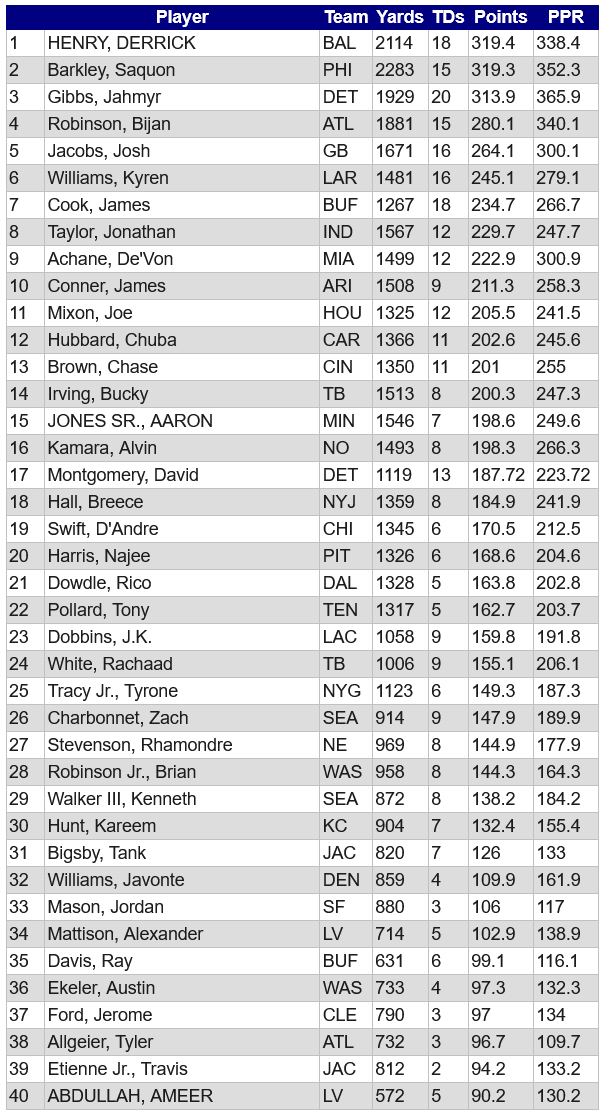
Observations:
There is nothing truly earth-shattering here, as we simply see the top 40 fantasy RBs from last season. Obviously many of these players will be high in the 2025 rankings with the presumption that they will have another successful fantasy season. What jumps out immediately is that -- unlike the WR position in which Ja'Marr Chase was in a league all his own -- there were 3 RBs ranked at the top with only a little over 5 points total separating RB1 (Derrick Henry) from RB3 (Jahmyr Gibbs). With such closely bundled scores, in fact, in many leagues those top 3 RBs may have been rated differently. Indeed, in PPR formats it was actually Gibbs that finished at RB1 with Henry dropping all the way down to RB4. Just another reminder to know your league scoring rules -- and pay particular attention to RBs who catch a lot of passes (see below) versus those who do not.
Also, unlike the WR position where stud players pop up out of nowhere, the RB landscape is far more predefined. Still, aside from the usual studs, there were at least a few surprise players such as Chuba Hubbard, Chase Brown, Bucky Irving, and even Rico Dowdle who all posted start-worthy numbers -- that is, finished as at worst a RB2 in 12-team leagues -- but were largely overlooked last year in fantasy drafts. Still, many of us tabbed these guys as potential Sleepers headed into 2024 -- and owners took a stab at them in the later rounds of many fantasy drafts. I suppose that brings up in a round-about way another overlooked factor with RBs compared to WRs: the dearth of available talent on the waiver wire post-draft as opposed to WRs.
Some of the more disappointing players were Rachaad White, Rhamondre Stevenson, Kenneth Walker III, and Christian McCaffrey (who doesn't even appear on this top 40 list) who were typically drafted with high selections in fantasy drafts yet seriously under-performed (in many cases due to injury).
Rushing Attempts (Carries)
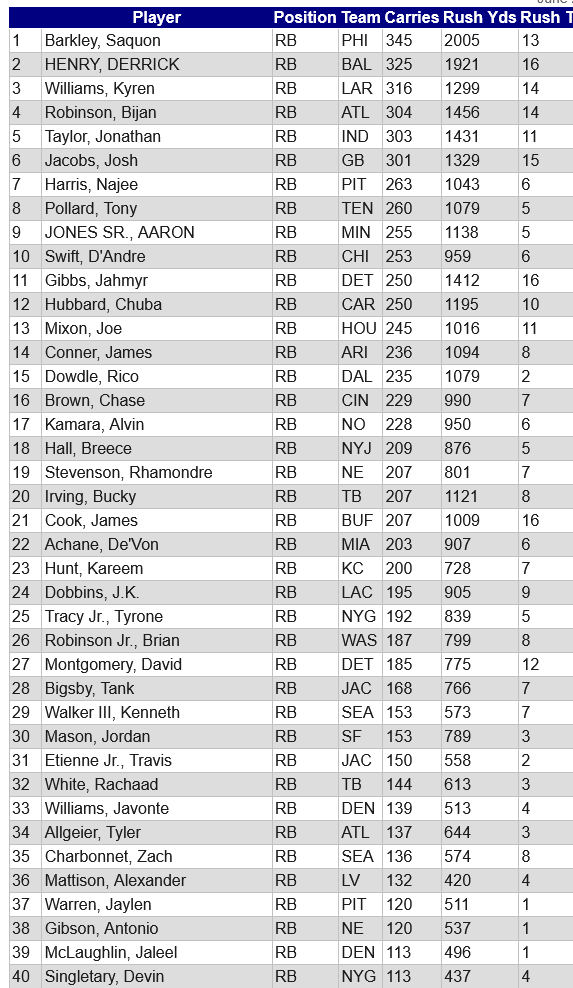
Observations:
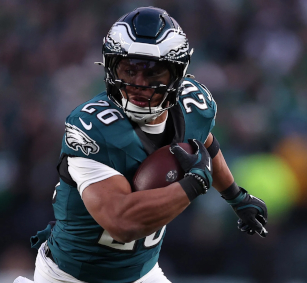
Before we dig into the extra value of RBs that are heavily used in the passing game, we would be remiss if we failed to evaluate the bread-and-butter attribute of running backs: their ability to run the ball. As I mentioned before, in 2024 we saw 23 RBs carry the ball at least 200 times -- and six (Barkley, Henry, Kyren Williams, B. Robinson, Jonathan Taylor, and Josh Jacobs) that eclipsed the 300-carry platitude. While all of these guys will be heavily considered as top RBs in fantasy for 2025, it is worth noting that history has shown us that heavy use of a RB in a single season can actually have lingering ill affects the following season. That could particularly be the case for Barkley, who has battled injuries in the past and also saw a good amount of passing targets to go along with a league-leading 345 carries (see below) -- and K. Williams who has also battled a history of injuries (mercifully with mostly a clean-slate in 2024) and whose smallish frame is not designed to withstand the brutality of the NFL. Meanwhile, that may be less of a concern for the freakishly big-bodied Henry, who nevertheless is battling father time at 31 years of age, which is ancient for an NFL running back.
Targets
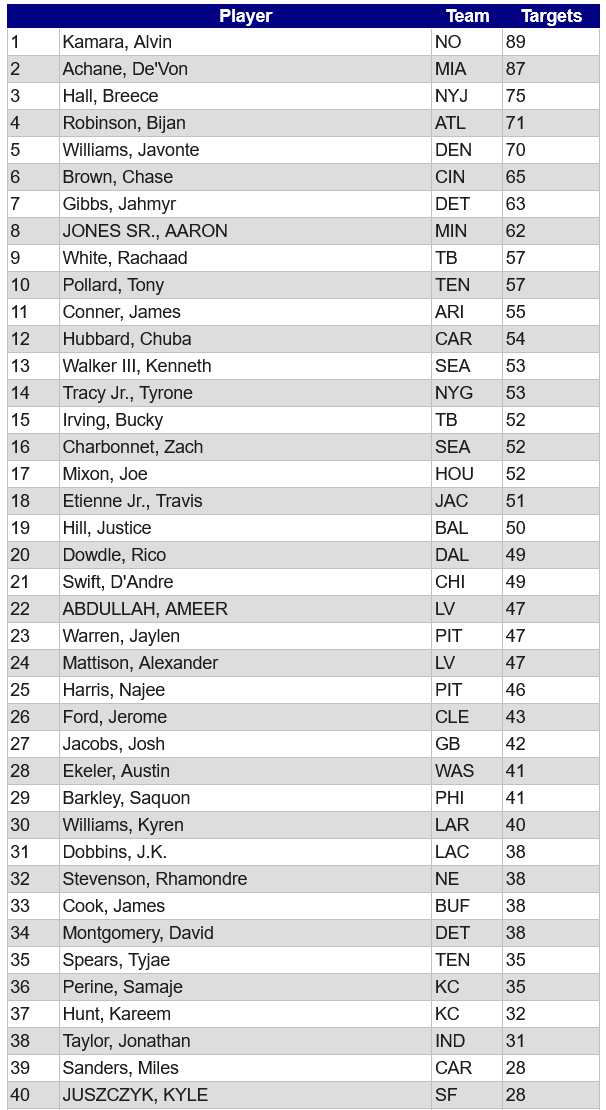
Observations:
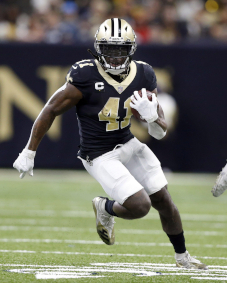
In a way, targets are even more interesting numbers to look at than receptions. I think of a reception as being the successful outcome of a target. Targets represent opportunities.
The mantra in fantasy, of course, is not to assume that opportunity leads to production. While that is also true with targets, of course, it makes sense that there is a direct correlation to receivers (in this case pass-catching running backs) who were heavily targeted in the passing game with those who had strong fantasy seasons.
That said, there is a specialization for some RBs to play only on 3rd downs and/or obvious passing downs. As a result, there were a number of RBs whose fantasy numbers were highly pumped up by their receiving numbers, while they were not nearly as visible in the rushing game. Javonte Williams, Zach Charbonnet, Kenneth Walker III, Travis Etienne Jr, Justice Hill, Ameer Abdullah, Jaylen Warren, Alexander Mattison, and Najee Harris were RBs who were among our top 25 most-targeted, but all FAILED to make the top 25 list in fantasy points scored.
Receptions

Observations:
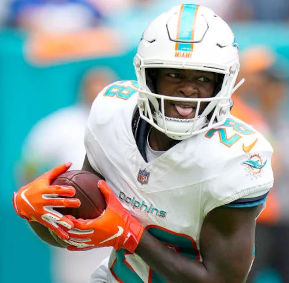
It makes sense that the RBs who saw the most targets (Kamara, Achane, Hall, Robinson, J. Williams) were also amongst the league leaders in receptions. That said, be wary of receivers whose hands are not the best -- guys who converted on a lower than expected rate of their targets on routes that are typically not exceptionally exquisite at the RB position. Note that 19 RBs saw at least 50 targets in 2024 -- but only nine of them managed to convert those opportunities into 50 or more receptions. Travis Etienne, Tyrone Tracy and Tony Pollard were all somewhat disappointing in these regards. While the opportunities were there to make them fantasy relevant in 2024, their lack of expected production in the passing game could lead coaches to explore other options at some point in 2025.
Total Breakdown (Total Touches)
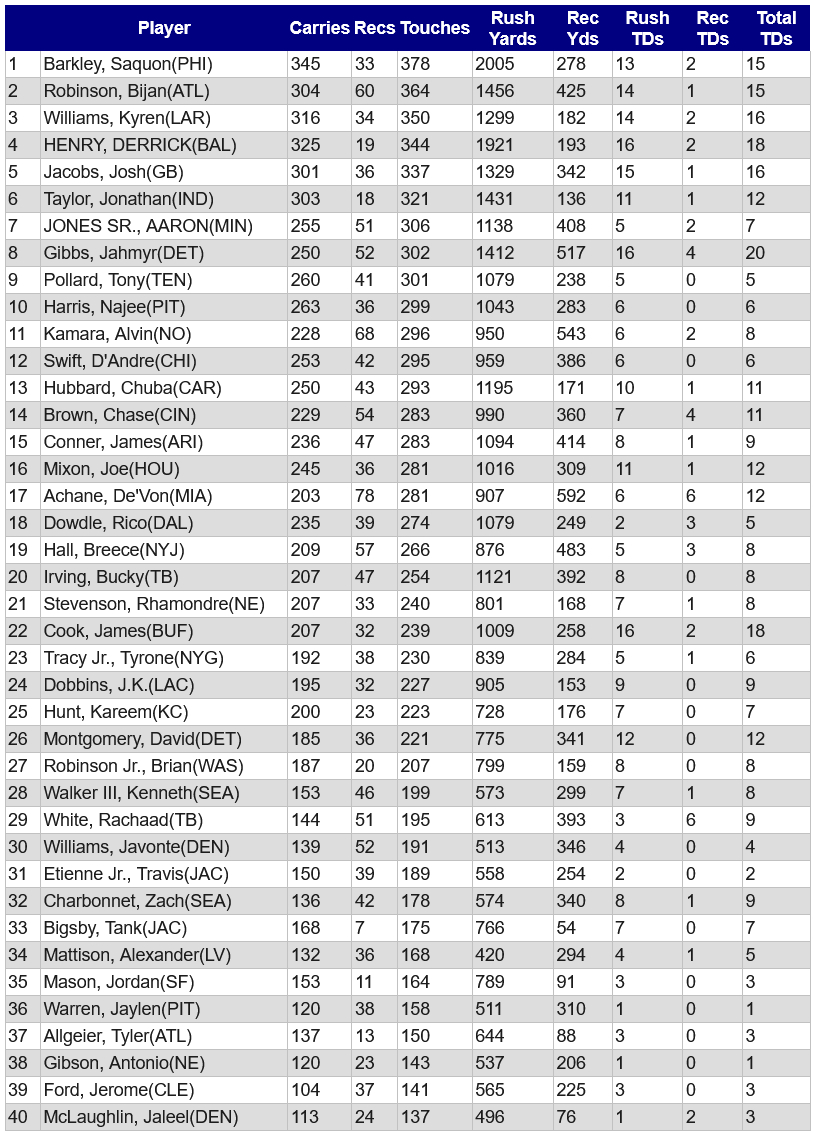
Observations:
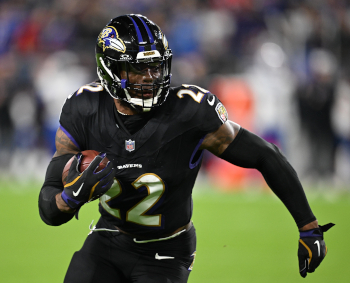
The real cream of the crop at the RB position are the guys who ranked toward the top in both carries and receptions. More specifically the RBs who ranked in the top 10 in both categories was an elite corps: B. Robinson (3rd in receptions and 4th in rushing attempts) and Aaron Jones (9th in both receptions and rushing attempts). Although J. Gibbs was close ranking 7th in receptions and 11th in rushing attempts.
Still, there were a number of RBs -- like Kamara, Hall, Brown, Conner, Pollard, and Swift -- who were used extensively in both aspects of the game to merit consideration as well. Meanwhile, soem RBs like Achane, J. Williams and R. White were studs in the receiving game but were part of a RBBC situation and did not see extensive carries. Conversely, D. Henry and J. Taylor were so heavily used in the running game that their limited targets/receptions in the passing game were not nearly as detrimental. To best account for the players who were productive in both categories -- or hyper-productive in one category or the other -- I love to examine those combined stats as touches.
Fantasy Points Per Carry
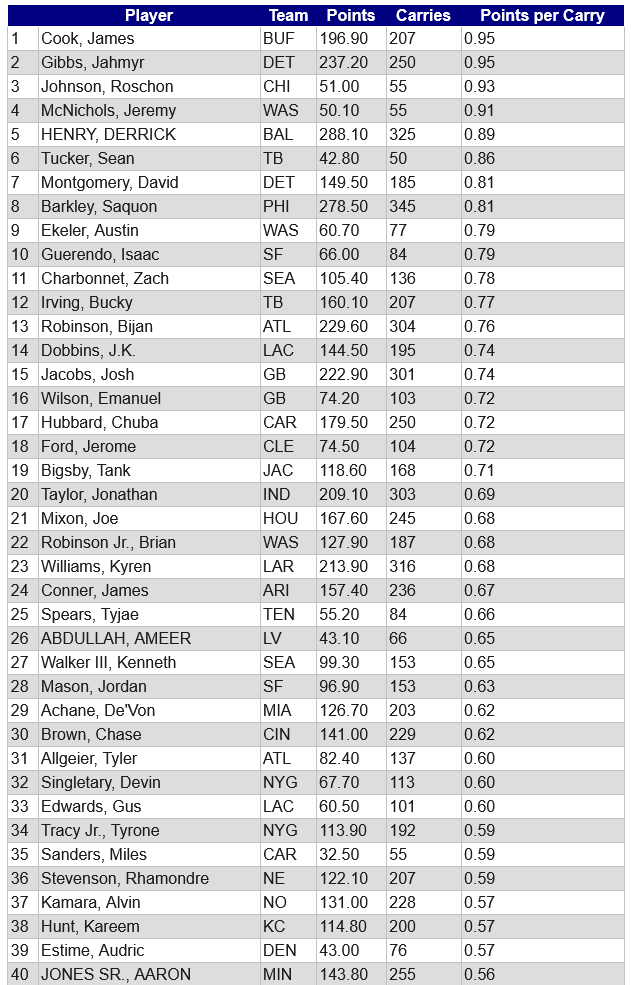
Observations:
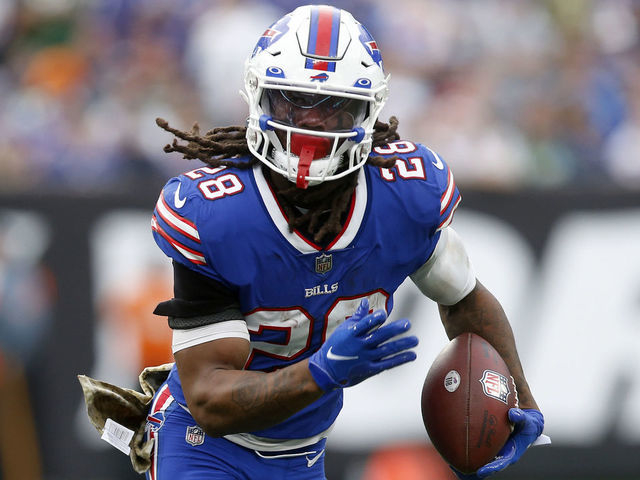
Here we look at the RBs that got hte most bang for their buck in the running game. That is, the players who scored the most fantasy points per carry. To fairly evaluate this, we look only at the fantasy points that were accumulated as part of the running game (rushing yards, rushing TDs) and ignore points acquired in the passing game to properly associate apples-with-apples.
Since we are concerned with running stats as well as passing stats in fantasy, this table may not be especially useful from a fantasy standpoint. However, it does help to evaluate the RBs that were particularly effective in the rushing game.
Note also, that this list sees a heavy boost for players who scored a hefty number of TDs. Note Gibbs, Cook, and Henry all with 16 rushing TDs ranking in the top 5 for fantasy points per carry. R. Johnson, J. McNichols, S. Tucker who all barely qualified with my limit of 50 carries or more managed to creep in the top 10 as well. I am not advocating drafting any of these guys -- but maybe keep an eye on them in their respective situations of the starter(s) ahead of them happen to miss any time.
Fantasy Points Per Touch
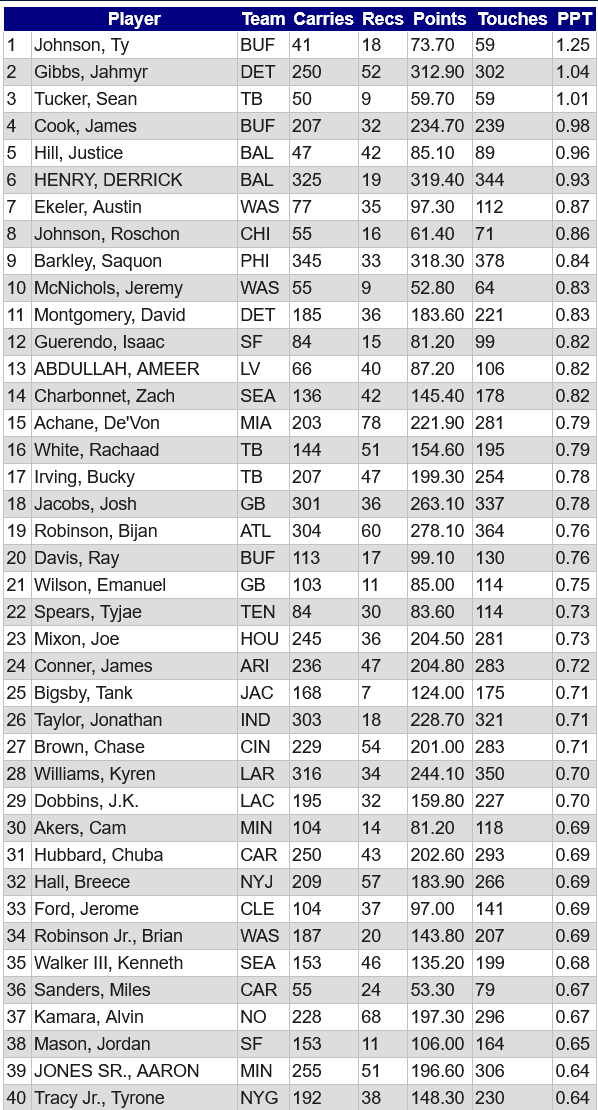
Observation
Here at least is my favorite manner of evaluation on an opportunity-versus-production level. For fantasy WRs, I like looking at Fantasy Points per Target. For fantasy RBs I prefer Fantasy Points per Touch, since touches (carries + receptions) is truly indicative of the number of opportunities presented to each running back. What I find especially interesting is that multiple players from the following teams -- Buffalo, Baltimore, Detroit, and Washington -- ranked toward the top of the list. All four of these teams bolster an effective running game, and (with the exception of Detroit) boast quarterbacks who are also big factors in the running game. That goes to show that in addition to volume and productivity, where a RB plays is also a key factor.
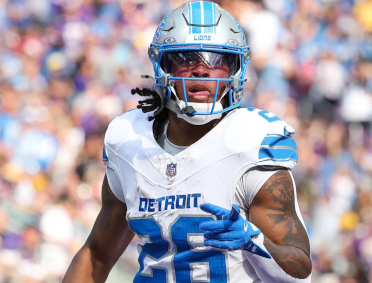
The real key to identifying fantasy relevance is to identify which running backs appear on this Fantasy Points Per Touch chart as well as the Total Touches chart. This will present you with the list of players who operated at a high fantasy level due to both volume and production and serves to weed out the players like Roschon Johnson, Jermey McNichols, Sean Tucker whose sample sizes were small enough to have been perhaps over-influenced by a couple of big plays.
Using such a formula gives us the following players who had the highest combined score on both charts:
1. Jahmyr Gibbs
1. Saquon Barkley
3. Derrick Henry
4. Bijan Robinson
5. Josh Jacobs
6. James Cook
7. Kyren Williams
8. De'Von Achane
9. Jonathan Taylor
10. Bucky Irving
11. David Montgomery
12. James Conner
13. Joe Mixon
14. Chase Brown
15. Chuva Hubbard
16. Rachaad White
17. Aaron Jones
18. Zach Charbonnet
19. Alvin Kamara
20. Breece Hall
21. JK Dobbins
22. Austin Ekeler
23. Tank Bigsby
24. Brian Robinson Jr
25. Justice Hill
26. Ameer Adbullah
27. Ray Davis
28. Najee Harris
29. Tyrone Tracy
30. Kenneth Walker III
31. D'Andre Swift
32. Isaac Guerendo
33. Rhamondre Stevenson
34. Tyjae Spears
35. Emmanuel Wilson
36. Rico Dowdle
37. Tony Pollard
38. Roschon Johnson
39. Jerome Ford
40. Kareem Hunt
Obviously this is far from scientific and fails to take other key factors (such as injuries, possibility of unusually bad/good season, new team, etc.) into account. It also ignores rookies entirely. But I think it represents an interesting and defensible baseline.